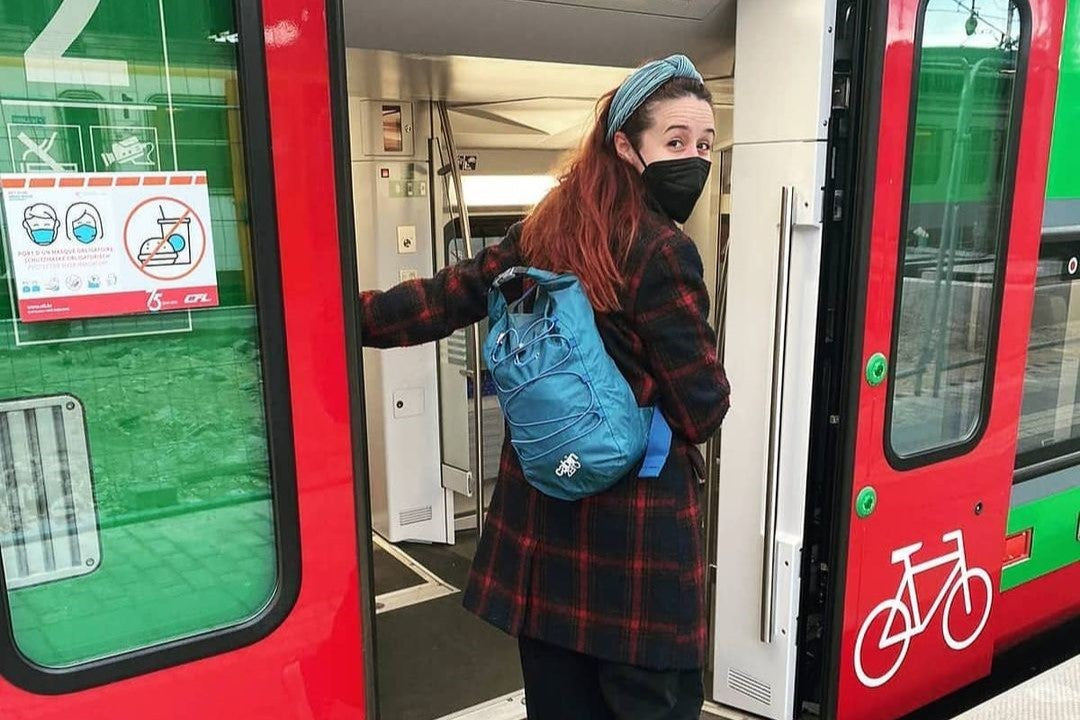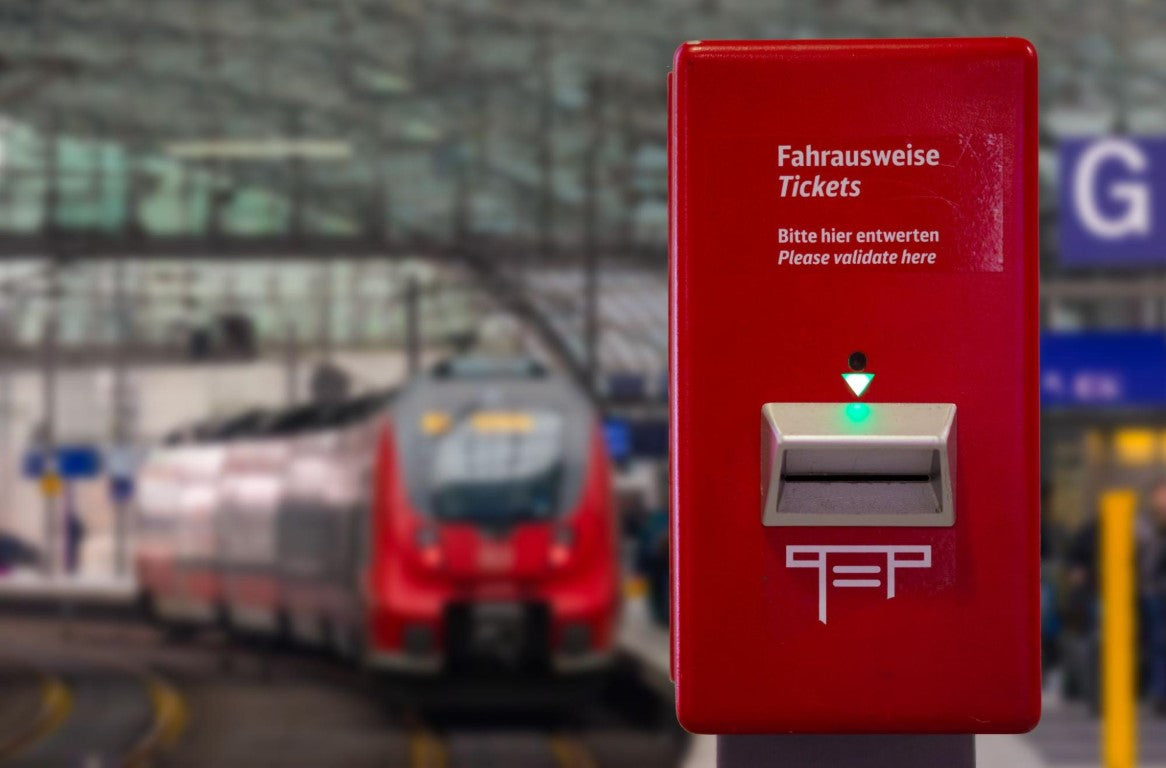CONTENTS
Guide To Buying Train Tickets In Europe: An European Train Travel Guide
Does buying train tickets in Europe and looking out the window to the breathtaking scenery sound like a recipe for a fantastic journey to you? If it is, you must learn the A to Z of buying train tickets in Europe to make the most out of your European journey. However, before putting rail journeys on your travel checklist, let’s look at whether they are the right transportation option for you.
Buying Train Tickets In Europe vs. Other Transportation
The cost

The Pros
Going from destination to destination around Europe can be a bit pricey, especially if you plan to buy lots of souvenirs and try out all of the best local food and cultural fun.
Taking the train is a smart choice to keep your spending within check for your whole European travel. Train tickets are generally cheaper and are easy to get depending on your type of travel (we will go into depth about this later section).
Compared to a car, the train is cheaper because you’ll not have to pay for toll fees or rental fees on days you only stroll the local area on foot. That’s not to mention the cost of gas, which may change depending on the area you’re in!
The Cons
A train ride is more cost-effective for solo travellers or a small group. However, it can be quite the opposite if you’re travelling in a large family and having to carry a lot of luggage.
The Experience
The Pros
It’s the obvious chance to see Europe in its natural glory while sitting in a train cab. In addition, a European station is often, in and of itself, a tourist attraction.
For example, the Paris’ Gare de Lyon is one of the world’s most iconic train stations. Its grandeur and classic French architecture that makes for fantastic photos. There are many more that are just as wonderful located around Europe, and you can absolutely build your itinerary around these stations.
Another great thing about travelling by train in Europe is that most stations are near central areas. You don’t have to worry about cutting your fun short to make up for the travel distance between where you are and the station.
On the same note, wouldn’t it be such a nuisance having to find a place to park your car or trying not to violate the local traffic rules because you’re not used to them? A train ride is much less troublesome!
Also, there is no lengthy custom queue of a flight or luggage limitation like that of a car’s trunk. Train travelling in Europe is a wanderlust’s dream.

The Cons
A train ride is only fun if you know what to expect. That being said, it can be a turn-off for those who are eager to reach their destinations since trains have to abide by a fixed schedule, and some destinations require more than one stop to reach.
Some hidden gems in small local towns or castle ruins in less-travelled areas may be far away from the stations. In that case, you might need to reconsider buying train tickets in Europe.
Buying The Right Train Tickets In Europe
Travelling by train in Europe is a perfect chance to see the many sides of Europe that travel magazines don’t talk about enough. In this guide to buying train tickets in Europe, you will find:
- What types of tickets are available?
- Where can you buy your tickets?
- How to get your tickets after buying online?
- Frequently asked questions
Let’s get started, shall we?
There are two types of train tickets in Europe: Point-to-point tickets and Rail passes. Depending on what your Europe travel itinerary looks like, each type has its own purpose and advantages.
Point-To-Point Tickets
Point-to-point tickets can be known as city-to-city tickets. As the name suggests, this type of train ticket is a great choice for domestic travel (for example, travelling from London to Liverpool) or international travel with only a few stops (such as Frankfurt and Paris).
These tickets can be purchased at the station or ordered online through ticketing websites. Prices may vary from site to site, so you might need to book a few days or months ahead to score the cheaper options.
However, it can be quite a hassle to get. They work like a regular bus ticket in any country and you have to stand in queue at the ticket booths just like the locals.

Sometimes, where you were and where you’re at do not use the same currency, so you might have to spend a bit of time to exchange your money beforehand.
These are some types of fare rates for you to choose from:
- Fixed-price ticket: National travel often uses this kind of ticket. Ticket prices will not be sold out or booked in advance. It’s pretty much like paying for a bus ticket in the city - prices are the same every day.
- Semi-flexible ticket: This is in a higher price range than a non-flexible ticket. You might have to book in advance because seats can be sold out. For a small additional fee, you can cancel and be refunded or change your travel time.
- Fully flexible ticket: This is the most expensive option as you will have more wiggle room for exchange, cancellation or switching to a different train. It works just like a semi-flexible ticket - booking ahead of time for a better price and better seat. However, not all fully flexible tickets mean the same (tricky, we know!) in every country, in some places the term is just referring to a flexible timeframe instead of a refund.
Rail Passes
There are typically two types of people who might be interested in purchasing a rail pass: people who plan to travel across many European countries; or the happy-go-lucky travellers who wouldn’t mind hopping on and off at any stop to explore what’s in store for them.
Either way, a rail pass allows for a more seamless travel experience because you do not have to wait in line for tickets, and one typically applies to a majority of stations around Europe. Rail passes can be budget-friendly, but they can also be counter-effective if you have no idea what you’re doing.

Let’s say you’re spending a week in France, another in Germany, and the last one in Italy. Sure, a pass from France to Germany seems ideal enough because you want to stop and visit the Louvre and breathe in the fresh air of the sea in Cote d’Azur for some days. Then spend the weekend drinking beer in Frankfurt and strolling from museums to museums in Berlin.
Buying point-to-point tickets for that many stops can be harsh on the budget. The problem starts when you get to Italy, and all you want to do is stay in Milan and lounge around.
Wouldn’t a Berlin-to-Milan ticket cost less than purchasing an entire pass since you’re not going anywhere else in Italy? This is why it’s important to make sure you will use a rail pass to its full potential before buying one.
Although a rail pass does not require a seat reservation, in certain cases, you still have to book a seat in advance. Sometimes, you will need to pay an extra fee here and there depending on which country you’re currently in.
Interrail vs. Eurail
Interrail and Eurail are two popular options for travelling around Europe by train. Here are some key differences between the two:
- Purchasing: to buy an Interrail pass, you have to be a holder of a European passport. Eurail passes, on the other hand, are exclusively available for non-European residents. Depending on your residency, the choice can be pretty obvious between the two.
- Coverage: Both passes allow you to travel nationally or internationally, i.e. across multiple countries. If your wanderlust heart yearns for a specific country, buy a single-country pass. Otherwise, you can buy a global pass.
- Flexibility: Both passes have wonderful flexible options that fit each unique travel plan. There is often a set duration of travel for you to choose from. For example, you can pick the 10-day-a-month plan or more. Each pass only counts for the duration of your stay, not the amount journeys you take.
- Pricing: A notable difference is that children under 11 travel for free with Eurail. Other than that, pricing pretty much depends on your travel plan. Some countries, like France and Italy, require an additional fee for seat reservations for both Eurail and Interrail. Eurail also offers discounts for certain attractions.

Flexipass vs. Consecutive-day Pass
Each country has their own rail pass if you only have one country on your travel plan. For instance, the Scandinavian Pass covers Denmark, Finland, Sweden and Norway. Overall, rail passes often come in two kinds:
- Flexipass: unlimited train journeys on the days you have selected when purchasing (between 7 and 90 consecutive days). Go for this if you want to linger at a location for longer.
- Consecutive-day pass: unlimited train journeys for the whole course of your journey (could be 1 or 2 months). It is ideal for those who travel to various places within a short time frame.
Where To Buy Train Tickets In Europe?
Directly At The Stations
Tickets are available for buying at any station. You can buy tickets on your day of departure or as early as you’d like.
This is one of the safest ways to buy tickets because you don’t have to worry about the Internet messing up your booking or waiting in a long line to get your online tickets at the station.
The downside is that you might not be able to have much freedom of choice in price if you buy at the ticket window on the day of travel.
Through Rail Companies’ Sites
Most railway companies in Europe have their official websites from which you can purchase your tickets. This is a preferred method of frequent travellers because these sites are reliable. You can compare prices across different sites to see if the other company offers a better deal for each stop.
For example, if you’re going to visit France, Switzerland and Italy. You can book your tickets through SNCF to go from France to Switzerland for as low as 28 Euros then continue with SBB to Italy. This is essentially cheaper than buying a ticket from France to Italy through only SNCF, which is about 200 Euros at the moment of writing.
These companies also sell rail passes (sometimes they name them differently to spice things up, but they are still the same thing) if you’re adding multiple stops to your international travel checklist.

Here are some countries and their official rail websites:
- The UK: National Rail
- UK to France: Eurostar
- Switzerland: SBB (Swiss Federal Railways)
- Germany: DB (Deutsche Bahn)
- France: SNCF (Société Nationale des Chemins de Fer Français)
- Italy: Trenitalia
- Spain: Renfe
- The Netherlands: NS (Dutch Railways)
- Belgium: SNCB/NMBS
- Austria: ÖBB (Austrian Federal Railways)
- Sweden: SJ (Swedish Railways)
- Norway: Vy (formerly NSB)
- Denmark: DSB (Danish national rail company)
- Finland: VR (Finnish Railways)
- Portugal: CP (Comboios de Portugal)
- Poland: PKP Intercity
- The Czech Republic: ČD (Czech Railways)
- Hungary: MÁV (Hungarian State Railways)
- Ireland: Irish Rail (Iarnród Éireann)
- Greece: OSE (Hellenic Railways Organization)
CabinZero tips: The German Railways Website (Bahn.de) has all the schedule of all train services across Europe. So be sure to make use of it when you are in the planning phase.
Through Third-Party Ticketing Sites
Sites like Omio or Trainline allow you to book your tickets both on the day of travel and in advance. So, what’s the difference between them and a regular official train ticketing site?
The fun in buying from these sites is that all the hard work of comparing prices across multiple railway companies has been done for you. All that’s left to do is pick the option you see fit and wait for your ticket to be sent straight to your phone.
Some people even believe them to be better than the official sites because they allow foreign credit card payments and are more friendly to non-European users.
Some third-party sites, like Klook, also come with all the other useful tools such as booking tickets for tourist attractions. Thus, they are worth a look if you want to be one of the first in line to see the Mona Lisa in the Louvre.
If you are not that good at planning a trip or your international travel checklist can be a bit overwhelming, you can buy the full packages, train tickets included, on sites like Byway and Railbookers.
How To Get Your Train Tickets in Europe After Buying Online?
If you buy your ticket at a ticket window at a station, you will receive it right then and there.
For online buyers, you can choose either the contact-free option or the collect-at-station option.
- Contact-free ticketing: This is applicable for the majority of tickets booked through third-party ticketing sites. Payment methods are more flexible. You can pay with your e-wallet, mobile banking account, or your physical card.
- Collect-at-station ticketing: If you book through an official railway company’s site, you may have to get your ticket at the self-serving machine at the station, but keep in mind that you’d need to pay and collect with the same physical card. Other forms of virtual payments may not be supported.
Some booking sites even have the option for home delivery. When you’re still enjoying your adventure elsewhere or at home checking your list of things to pack, your train tickets in Europe will still be happily sent to you.
Methods to get your tickets are very flexible. Just pick the one you feel the most comfortable with.
FAQs
Still having some problems with buying train tickets in Europe? Check out these commonly asked questions.
1. How Soon Can I Book My Tickets?
Just like accommodation prices, train tickets are subject to change constantly. In some countries, you can book as far as 6 months in advance, whereas in others, this window is only open for 1 month.
Here are some usual timetables for advance booking that we know of:
- Some railways in Italy, Austria, France and Germany: 4 to 6 months in advance
- Spain: 2 months in advance, with the exception of trains to and from Madrid that allow booking 6 months in advance
- Great Britain: 3 months in advance
- Denmark and Hungary: 2 months in advance
- Poland: 1 month in advance
Another thing to keep in mind is that difficult booking sites will release advance tickets at different times, depending on where their ticket source is located.
For example, France and Denmark have two different booking timeframes. You might not be able to see the same journey listed for booking on a Denmark-based booking site even if it shows up on a French one. You can either wait until more options pop up or just purchase whichever you like.
2. Why Can’t I Book My Tickets When My Journey Is Available?
This can be concerning for first-time travellers. Imagine packing all the things you need and checking every item on your international travel checklist just to get hit with a notice of an unavailable ticket. The reason this happens is that some stops are not covered by the national booking site you’re looking at.
There’s nothing to panic about because this can be easily solved. You can switch to a third-party ticketing service that allows a broader range of international stops. The price may change, but at least you know your trip is still safe and sound.
Another solution is to split your bookings into different sites, one over here and another over there, until all your stops are covered. Doing this is a bit time-consuming but doable.
3. Should I Arrive Early At The Station?
Taking a train is like catching a flight but without all the hassles of a security check and customs declaration. However, there are a few rules of thumb you need to pay attention to before boarding.
First, make sure you arrive at the station at least 20 minutes before the time on your ticket. This is because some stations in Europe are massive and packed to the brim with commuters. Locating your platform and queuing in line to get your ticket (if you choose to collect at the station) can take a while, especially for first-timers.
Second, the numbers and letters on your ticket are there for a reason. Read carefully and pay close attention to important details like your train number, your platform and your line. The last thing you want to do is get on the wrong train and risk missing all the other subsequent rides.
4. Is There Any Luggage Regulation On The Train?
There is typically no limitation on how much you can carry on the train unless it causes a problem for you or other passengers. Small luggage can be stored right where you’re sitting; bigger ones can go on the rack by the door or above your head.
Carry-on items are practically the same as any other public transport; for example, no firearms and explosives. But to be absolutely sure, you can read all the information upon booking or just ask a train officer.
Some trains require you to put your name on your luggage, like the Eurostar or French train.
The key point is that although luggage regulation is not as strict as when you’re flying, it’s important to read the guidelines of the train you’re travelling on carefully before boarding.
Keeping Your Belongings In Europe Safe With The Right Bag

A guide to buying train tickets to Europe is incomplete without this reminder: trains are made to hop on and off quickly, and you might find wheeling your bulky suitcases around a hassle, especially on a crowded platform. Also, imagine what a nuisance it is to hold onto your spinner suitcase with one hand while trying to grab your tickets with the other!
We recommend travelling with something more lightweight and hassle-free but equally secure, like a backpack. Take a look at our recommendation - the CabinZero Classic Backpacks.
…And that’s it. You’re all set for your journey in Europe by train. Don’t forget to leave a comment if you find this guide useful and send it to your travel buddies to ensure they’re all on board with your Europe travel plan.
Nguyen Tran Gia Khanh














Thank you for making such a useful post 👍🏻👍🏻
Leave a comment